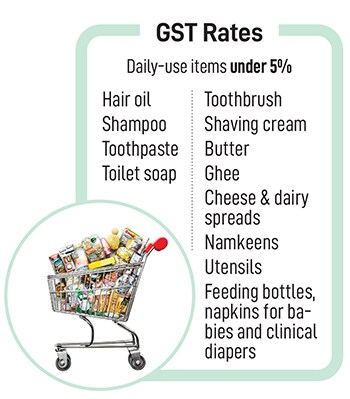GST rate cut brings relief, but packaging transition remains a concern
The government has allowed old packaging with new stickers or stamps to ease GST shift, but the transition may be a challenge


The government’s cut in Goods & Services Tax (GST) rates has brought festival season cheer for consumers, but has raised fresh challenges for manufacturers, retailers, and distributors. With concerns around existing stock and packaging that reflects old prices, the industry is now gearing up to manage a smooth and timely transition.
On September 3, the GST Council announced rates largely under two slabs—5 percent and 18 percent. While essential items were exempted, goods from the old 12 percent and 28 percent slabs were moved to lower rates and luxury and sin goods remained unchanged at 40 percent.
As a result, daily use items such as hair oil, shampoo, toothpaste, toilet soap bars, toothbrushes and shaving cream, which were earlier levied 18 percent, fell to 5 percent. Other items such as butter, ghee, cheese, dairy spreads, pre-packaged namkeens, bhujia and mixtures will now see a drop from 12 percent to 5 percent.
Although the new rates will be effective from September 22, the duration isn’t enough for shelves to be stocked with products with new packaging.
What makes it even harder is that typically, manufacturers hold at least two to three months of inventory, and a large portion of packaging materials is pre-printed with the current maximum retail price (MRP).
Therefore, to avoid a loss worth ₹2,000 crore, according to estimates, amid appeals from manufacturers, the government has allowed them to use existing packaging. In a circular issued by the Department of Legal Metrology under the Department of Consumer Affairs, they could stamp or put stickers, without overwriting the original MRP. This is applicable until December 31 or until stocks are cleared, whichever is earlier.
Had the government not made this decision, it would have had a notable impact on sectors such as packaged foods and personal care, where lost sales are difficult to recover, explains Pushan Sharma, director, Crisil Intelligence. “Distributors and retailers would likely have stopped replenishing stocks ahead of the implementation date, resulting in a decline in monthly sales and ultimately, annual sales.”
Welcoming the timing of the move, Saurabh Agarwal, tax partner at EY India, says, “This measure directly addresses two critical areas—ensuring consumer price transparency while preventing the substantial wastage of packaging materials.”
Agarwal adds that the extension till the end of the year offers flexibility, especially for sectors such as FMCG and pharmaceuticals that manage large inventories. The new order, he says, “…enables companies to efficiently utilise existing stocks, mitigate raw material costs and ensure a seamless transition to the new GST rates without supply chain disruptions.”
As per the government’s order, manufacturers, packers, or importers must also publish at least two advertisements in newspapers to inform dealers, along with the central and state legal metrology authorities, about the price change. “This reinforces the commitment to passing on tax rate reductions to the end consumer. This not only safeguards consumer interests but also promotes accountability throughout the value chain,” Agarwal explains.
For manufacturers like Zydus Wellness, the GST revision is a step in the right direction, says its chief executive officer, Tarun Arora. “It will make products affordable and drive consumption through a reduction in prices, especially before the festival season when there is a significant increase in shopping,” he notes.
However, the timing of the move will impact festival readiness, since 75 percent of the company’s portfolio, including products such as Complan, Sugarfree and Glucon-D and others, will undergo revision in rates.
“We intend to ensure that the entire benefit is passed on to consumers. That said, it is important to appreciate the inherent complexity of the FMCG value chain, which typically spans 60 to 120 days. In a country as vast as India, with the massive volume of products already in circulation, implementing physical changes such as stickering or stamping across stock is an intricate and time-intensive exercise,” Arora says.

The key lies in managing this transition thoughtfully and balancing scale, speed and consumer benefit, so that the change is both smooth and meaningful, he explains. In addition, at this point, the financial implications of stamping, or adding stickers, have not been calculated, he says. “We are still waiting for the government to issue all clarifications,” he adds.
However, the deadline to sell unsold stock with original price and stickering/stamping by December 31 may not give enough time, according to Arora. For instance, for seasonal products, a three-month window may not be sufficient to clear the stock.
On the sales impact, he notes that trade is resisting purchases, which may have a short-term impact. In the long term, it will translate into higher consumption for some of the categories, he anticipates.
Agarwal highlights some concerns. First, if the base price can be adjusted to account for additional costs stemming from factors such as input tax credits that will not be able to be utilised and working capital pressures or the loss of area-based exemptions. “Addressing these will be vital for a truly comprehensive and supportive policy framework.”
And lastly, a clarification stating that re-stickering or price revisions are not required for stock already in the hands of distributors and retailers would bring significant relief for the industry, he reckons.
“As practically, it is extremely difficult to manage re-stickering, relabelling, online printing across the entire distribution chain… such a move would largely resolve a major operational challenge for the industry and help in a smooth transition,” says Agarwal.
First Published: Sep 16, 2025, 12:07
Subscribe Now
